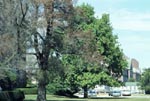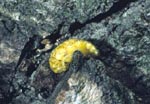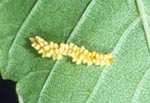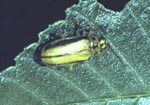Elm Leaf Beetle
Pyrrhalta luteola
Description

Figure 1. Elm Leaf
Beetle Larva and Feeding
Damage
The adult beetle is about 1/4 inch long, with yellowish legs and antennae. The body is yellowish to green with several black spots on the head and thorax and a black colored stripe on the outer margin of each wing cover. The larvae all smaller than the beetle, are dirty-yellow to black, ugly, and spiny. They are 1/2 inch long when full grown. Elm leaf beetle pupae are bright yellow and found at the base of the host tree. The lemon yellow spindle-shaped eggs are laid in clusters on the undersides of the leaves.

Figure 2. Elm Leaf
Beetle Damage on
American Elm
Life History
The beetles, which overwinter in protected places and sometimes in dwellings and other buildings, become active in the spring. When the leaves unfold, the females deposit their eggs on the undersides of elm leaves. After the larvae feed for three weeks or so, they pupate in cracks and crevices of the bark or at the base of the trees. The adult feed by chewing clear through the leaf resulting in a shot-hole effect while the larvae feed from the underside of the leaf resulting in a skeletonization of the leaf tissue. The larvae feed for approximately three weeks before descending the trunk to pupate. There are two generations each year.
Damage

Figure 3. Elm Leaf
Beetle Pupa
Although the elm leaf beetle attacks several species of elm, it is particularly fond of Siberian elm (Ulmus pumila), but may feed on other elm species as well. In feeding, the adult beetles eat small round holes in the leaves, but the more-destructive larvae completely skeletonize the leaves from the undersides. Where damage is severe, the leaves dry, curl, and fall prematurely.

Figure 4. Elm Leaf
Beetle Eggs
Nonchemical Control
A naturally egg parasite has been to be effective in certain areas and is currently being developed for mass releases. Resistant elm hybrids are also being developed that would be less susceptible for elm leaf beetle feeding.

Figure 5. Adult Elm
Leaf Beetle and Feeding
Damage
Chemical Control
Microbial or conventional sprays may be applied in the spring when the first adult feeding is observed.